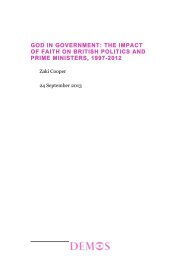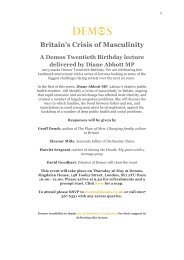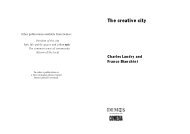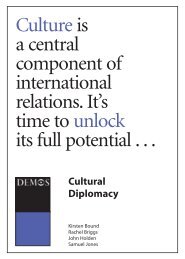Adrian Ellis, Director of AeA Consulting - Demos
Adrian Ellis, Director of AeA Consulting - Demos
Adrian Ellis, Director of AeA Consulting - Demos
You also want an ePaper? Increase the reach of your titles
YUMPU automatically turns print PDFs into web optimized ePapers that Google loves.
graphic, product and textile design, fashion, computing and advertising, in pursuit <strong>of</strong><br />
commercial objectives. Chris Smith, when Minister <strong>of</strong> Culture, launched a ‘mapping<br />
exercise’ that concluded that the creative industries (subsuming the arts sector) accounted<br />
for some 5% <strong>of</strong> GDP and underlined this broad definition <strong>of</strong> culture by the publication <strong>of</strong><br />
his book <strong>of</strong> essays Creative Britain that co-located both commercial creativity and culture<br />
as central to the objects <strong>of</strong> cultural policy, with what was widely interpreted at the time as<br />
a stronger policy interest in the former.<br />
It is not the purpose <strong>of</strong> this note to <strong>of</strong>fer an extensive critique <strong>of</strong> the basis for current<br />
cultural policy. It is, however, the intention to signal the growing academic literature that<br />
draws attention to the lack <strong>of</strong> empirical evidence for many <strong>of</strong> the more bald assertions in<br />
policy discussions about the socially and economically benign impact <strong>of</strong> investment in the<br />
arts.<br />
Perhaps the biggest disconnect between policy and broad academic consensus is in the<br />
area <strong>of</strong> economic impact studies. Economic impact studies generally seek to provide a<br />
rationale for investment in the arts, usually capital investment, on the grounds that the<br />
capital expenditure and subsequent operating expenditures will generate further<br />
expenditures that are higher than those for comparable forms <strong>of</strong> investment. They are, in<br />
Bruce Seaman’s phrase ”A fashionable excess …diverting attention from the kinds <strong>of</strong><br />
research most appropriate for building a legitimate case for further public support <strong>of</strong> the<br />
arts.” 8<br />
The now widespread critique <strong>of</strong> impact studies has several thrusts: they fail adequately to<br />
account for the opportunity cost <strong>of</strong> investment; their definitions <strong>of</strong> cultural activity are<br />
overly-generous in practice even where the surrounding rubric suggests they are taking a<br />
narrow definition; and estimates used for funding proposals are almost never compared<br />
against actual outcomes so that some empirical basis can be built up to test assertions.<br />
© AEA <strong>Consulting</strong> 10






